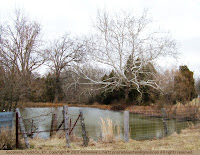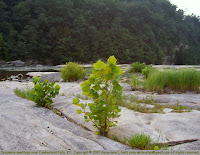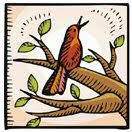American planetree, "buttonball," Platanus occidentalis
 |
| Sycamore growing beside a creek |
 |
| Sycamores are water-loving trees. |
The bark of the sycamore is one of its best identifying features. Mottled below and grayish-white on its upper branches, with some patchy peeling, it can hardly be mistaken. If leaves are not present, look for the sycamore's fruit, the brownish "buttonballs" that appear in late summer. A few fruits will often hang on until the next spring. (I noticed several sycamores today with fruit still very obvious in their upper branches.)
Though the sycamore is a beautiful tree in its natural habitat, think twice about where (or whether!) to plant it in your yard. It often grows up to 100 feet in height and breadth, and it's a rather messy tree, dropping lots of little branches and big leaves all the time. Also, it tends to put out large surface roots that will interfere with lawn mowing. (I am speaking from personal experience.)
 |
| Small sycamores growing in a rock crevice very near Cumberland Falls (in Kentucky) |
My husband has often said to me jokingly that we see a lot of big sycamores in Kentucky because sycamore lumber is useless. However, I read tonight that sycamore lumber is usable if properly cured to control warping due to a high degree of shrinkage. Perhaps inadequate curing explains the conventional wisdom that sycamore firewood won't burn.
American sycamore is grown in short-rotation plantations primarily for pulp and it also is used for rough lumber. The heavy, close-grained wood is difficult to split and work because of interlocking fibers. It has been used for butcher's blocks, furniture, veneer and interior trim, boxes and crates, flooring, and particle and fiberboard.
Source: USDA Plant Guide (pdf)
 Probably the main reason that we see a lot of big sycamores in Kentucky is that the tree is very fast growing. In just 20 years, it can grow 70 feet tall!
Probably the main reason that we see a lot of big sycamores in Kentucky is that the tree is very fast growing. In just 20 years, it can grow 70 feet tall!
 "The power to recognize trees at a glance without examining their leaves or flowers or fruit as they are seen, for example, from the car-window during a railroad journey, can only be acquired by studying them as they grow under all possible conditions over wide areas of territory. Such an attainment may not have much practical value, but once acquired it gives to the possessor a good deal of pleasure which is denied to less fortunate travelers."
"The power to recognize trees at a glance without examining their leaves or flowers or fruit as they are seen, for example, from the car-window during a railroad journey, can only be acquired by studying them as they grow under all possible conditions over wide areas of territory. Such an attainment may not have much practical value, but once acquired it gives to the possessor a good deal of pleasure which is denied to less fortunate travelers."
0 comments -- please add yours:
Post a Comment